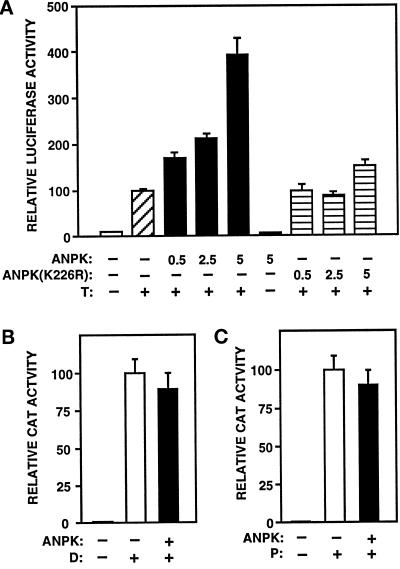Figure 9.
ANPK enhances androgen-induced transcriptional activation. (A) CV-1 cells were transfected using the calcium phosphate method with 5 μg of pPB(-285/+32)-LUC reporter plasmid along with 0.5 μg of pSG5-rAR and indicated amounts (μg) of pFLAG-ANPK(159–1191) or kinase-defective pFLAG-ANPK(K226R) in the presence or absence of 100 nM testosterone (T) as depicted. Total amount of DNA was kept constant by adding empty pFLAG-CMV-2 expression vector as needed. β-Gal expression plasmid, pCMVβ (2 μg/10-cm plate), was used to control for transfection efficiency. Luciferase (LUC) activities were normalized using β-gal activity. LUC activities are expressed relative to that of pSG5-rAR in the presence of testosterone (= 100), and the mean ± SE values of at least six independent experiments are given. (B and C) ANPK does not modulate PR- and GR-dependent transcription. (B) CV-1 cells were transfected with 5 μg of pARE2-E1b-CAT reporter containing two copies of the GRE/PRE/ARE motif of the rat tyrosine aminotransferase gene upstream of the adenovirus E1b TATA sequence along with 0.5 μg of pSG5-hGR, 5 μg of empty expression vector (pFLAG-CMV-2) (open bar) or pFLAG-ANPK(159–1191) (solid bar), and 2 μg of pCMVβ in the presence or absence of 100 nM dexamethasone (D). (C) CV-1 cells were transfected as in panel B, but using 0.5 μg of pSG5-hPR1 instead of pSG5-hGR in the presence or absence of 100 nM progesterone (P). CAT activities are normalized to β-gal activity and expressed relative to those achieved with pSG5-hGR or pSG5-hPR1 in the presence of P or D, respectively (= 100), and the mean ± SE values of at least three independent experiments are shown.

